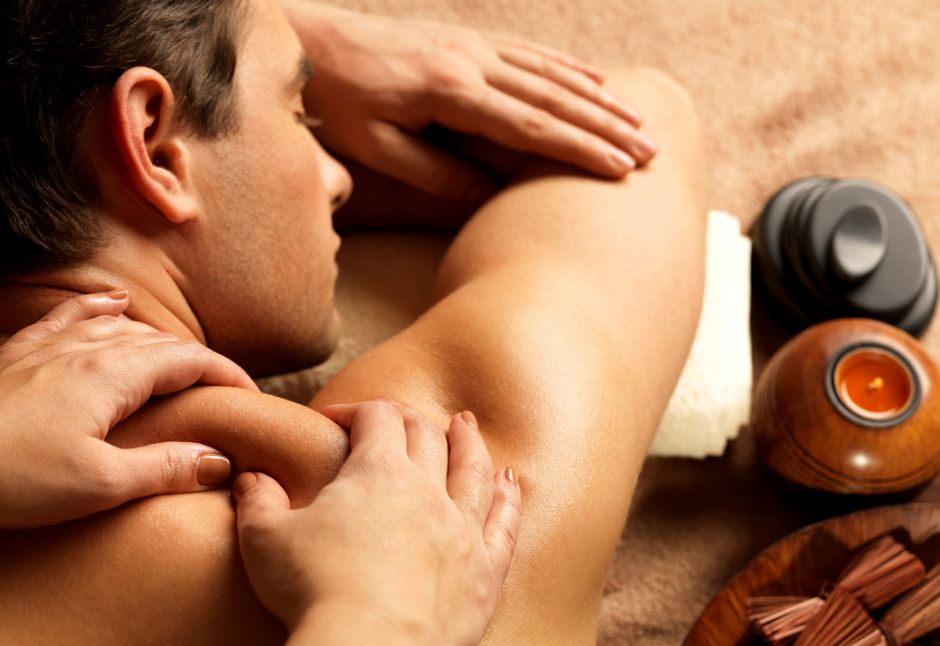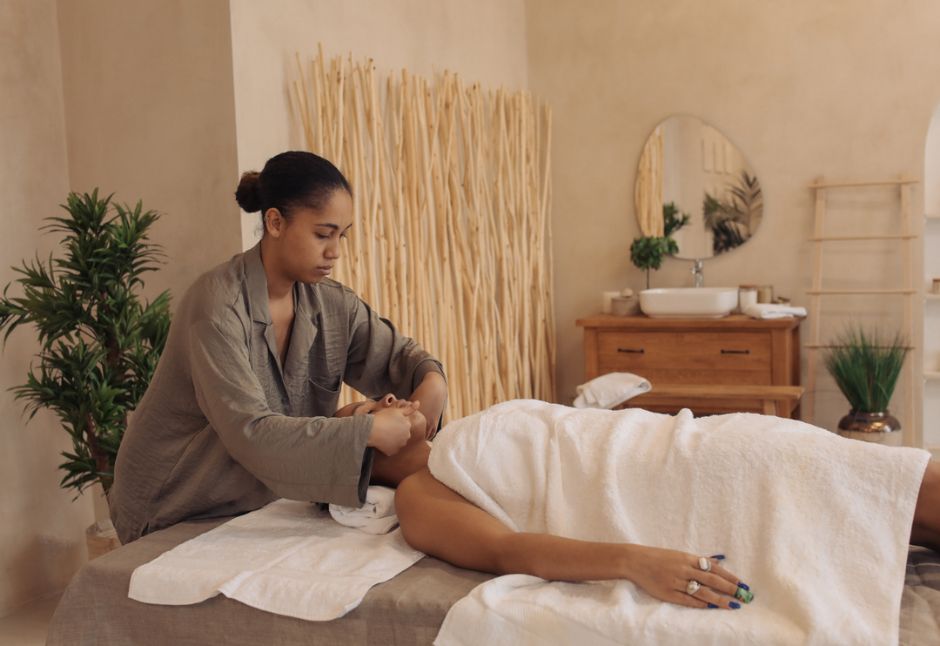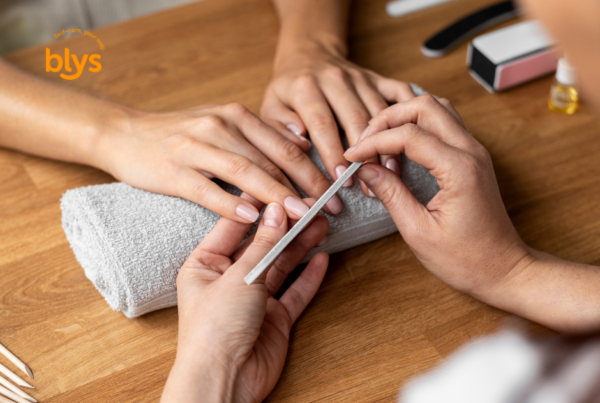
When done right, deep tissue massage for muscle knots can be a great tool to address these knots, which are also known as myofascial trigger points. The myofascial trigger points are sensitive muscle areas that cause pain, stiffness, and reduced mobility if not addressed.
With the firm pressure applied during a deep tissue massage, these adhesions break down slowly, increasing the blood flow and restoring flexibility. There are specific placebo-controlled studies suggesting that the massage can significantly reduce pain and improve range of motion in individuals having chronic muscle tension.
What are muscle knots and trigger points?

Muscle knots are also called myofascial trigger points. These can be described as hyperirritable, present in taut bands of muscle fibers. One can experience localized tenderness and referred pain due to these knots or trigger points. These muscle knots might also limit the range of motion.
There are many reasons for these knots to form, including muscle overuse, poor posture, or stress, as they can lead to persistent muscle tension. These muscle knots usually develop in the neck, shoulders, lower back, and calves and usually feel like small, hard lumps.
What is deep tissue massage, and how does it work?
Deep tissue massage is a therapeutic massage technique that focuses on applying sustained pressure to penetrate deep into muscle layers. This helps realign the muscle layers and connective tissue to help reduce chronic tension and pain.
Here’s a look at how this massage therapy for knots helps one deal with muscle tension and trigger points.
- Massage therapists use sustained pressure along with slow, deep strokes to reach the inner layers of muscles and surrounding tissues. This helps break down knots that might stand in the way of improving blood circulation.
- The massage applies deep finger pressure to release muscle knots and alleviate chronic patterns of tension in the body.
- With the enhanced blood circulation to the areas facing tension, the massage promotes relaxation and aids in the healing process.
- Deep tissue massage for muscle knots also helps break up scar tissue that forms after an injury, thus reducing tension in the muscles and tissues. This further speeds up the healing process by reducing inflammation.
How does deep tissue massage relieve muscle knots and improve muscle function?
Here are some of the ways through which deep tissue massage can relieve muscle knots and improve muscle function.
- Deep tissue massage applies firm pressure and slow strokes to target muscle knots. This helps relieve pain and restore normal movement.
- The pressure that a massage therapist applies increases muscle flexibility, leading to a better range of joint motion and decreased stiffness.
- The constant pressure applied during a deep massage process encourages muscle relaxation, helps release tight knots, and reduces discomfort.
What techniques are used in deep tissue massage for releasing muscle tension?
Deep tissue massage for muscle knots uses various techniques to help alleviate muscle tension by targeting deeper muscle and connective tissue layers. Here is a detailed look at these techniques.
Using Friction and Muscle Stripping to Break Down Adhesions
The deep tissue massage is a pain relief massage that uses specific techniques like friction massage and muscle stripping to address muscle tension.
- Friction Massage:
- Applies deep, transverse movements across muscle fibers to prevent or break down adhesions.
- These movements also help mobilize scar tissue, improving flexibility and reducing discomfort.
- Muscle Stripping:
- Under the stripping method, deep, gliding pressure is applied along the length of the muscle fibers, i.e, from the muscle’s origin.
- The method uses fingers, knuckles, and thumbs to help realign muscle fibers, break down knots, and decrease muscle tension.
- This promotes better muscle function and alleviates pain.
Trigger Point Therapy for Myofascial Knot Relief
The main aim of trigger point therapy is to alleviate myofascial knots or trigger points in muscle tissue that usually cause pain and limit mobility.
- Identifying Trigger Points:
- Therapists begin by locating hyperirritable spots in the muscles.
- These points are tender to touch and may cause referred pain in other areas.
- Pressure Application:
- Constant and direct pressure is applied to these points using fingers, knuckles, or even special tools.
- This helps release the tightness in the muscle and improves blood flow.
- Pain Relief and Improved Function:
- When trigger points come undone, individuals will experience an immediate reduction in muscle pain.
- This, in turn, increases muscle flexibility and enhances the range of motion.
Manual Pressure Tools: Elbows, Thumbs & Forearms in Deep Tissue Work
In deep tissue massage, therapists use their elbows, thumbs, and forearms to address muscle tension and adhesions.
- Elbows: By using elbows, therapists can apply concentrated and deep pressure to specific areas of dense muscle tissue. This helps release chronic knots and adhesions.
- Thumbs: Thumbs provide precise control, helping focus on smaller, localized muscle knots and trigger points more accurately.
- Forearms: Since forearms cover a larger surface area, pressure can be distributed more evenly. This also reduced the strain on the therapist’s hands and wrists.
Breathing Techniques and Positioning for Effective Deep Muscle Release
By incorporating specific breathing techniques using proper positioning during deep tissue massage, one can significantly enhance muscle relaxation and release. Here is a look at both these aspects.
Breathing Techniques:
- Diaphragmatic Breathing: Deep, belly breathing that activates the parasympathetic nervous system. As a result, it leaves individuals relaxed and with reduced muscle tension.
- Extended Exhalation: With longer exhalations compared to inhalations, the nervous system calms down faster, and this facilitates deeper muscle release.
Positioning Strategies:
In deep tissue massage, it is important to have effective positioning. This applies to both the client and the therapist to ensure comfort, safety and to achieve the desired outcomes. It is important to ensure proper client alignment with the help of appropriate support.
What are the benefits of deep tissue massage for chronic knots and muscle recovery?
Here is a list of all the benefits that deep tissue massages hold for chronic knots and muscle recovery.
- Deep tissue massage applies firm pressure and slow strokes to target and release persistent muscle knots. This further helps in reducing pain and discomfort.
- The technique also helps break down scar tissue and improves flexibility and range of motion.
- Deep tissue massage also promotes better blood flow to affected areas. This helps reduce inflammation and deliver oxygen and nutrients crucial for muscle repair.
- With regular deep tissue massage sessions, individuals will also be able to reduce Delayed Onset Muscle Soreness or DOMS, thus aiding in quicker recovery after intense physical activities.
- The benefits of deep tissue massage for muscle knots are not just limited to the physical aspects. It can also lower stress levels, contributing to overall mental well-being.
How do you choose a licensed deep tissue massage therapist?
 Here are a few steps you can take into account to find a qualified massage therapist for muscle knots.
Here are a few steps you can take into account to find a qualified massage therapist for muscle knots.
- Start by asking your healthcare provider, like your doctor or physical therapist, for recommendations.
- You can also ask your friends, family, or colleagues for recommendations based on their personal experiences.
- Explore online platforms to search for and book appointments with qualified Deep Tissue Massage therapists.
- Once you have shortlisted the therapists, ensure that they have completed formal training from an accredited institution and have a valid practising license.
- Talk to them about your specific muscle knot issues and determine whether or not your treatment goals align with their methods.
- Your therapist should also be open to receiving feedback about the treatment plan.
- Make sure the treatment space is hygienic and you feel comfortable in it.
Is deep tissue massage safe? Contraindications and risk factors explained
Deep tissue massage for muscle knots is usually considered a safe method to indulge in. However, it is important to consider safety precautions and the contraindications to avoid any potential adverse effects.
Some of the safety considerations to remember include:
- Anatomical Awareness: The massage therapist should be particularly aware of all the important trigger points and how much pressure to apply to these points to ensure the release without making it too painful.
- Qualified Practitioners: The therapist performing the massage should be licensed and have experience.
- Communication: You must communicate effectively during the massage process if you experience any pain or discomfort.
- Post-Massage Effects: The post-massage phase might consist of mild soreness. However, if you face severe or prolonged pain, you should discuss it with a healthcare provider.
Contraindications:
- If you are dealing with advanced osteoporosis, avoiding deep tissue massage is advisable as the pressure applied could risk bone fractures.
- Conditions like uncontrolled high blood pressure or a history of blood clots could cause complications, and individuals suffering from them should avoid deep tissue massages unless okayed by their healthcare provider.
- Pregnant women should consult their healthcare professionals before undergoing deep tissue massages.
- Cuts, burns, or skin infections should not be massaged as that might worsen their condition and lead to the spread of infections.
- Anyone who is on medications like blood thinners though avoid the massage as it might increase the risk of bruising or bleeding during a massage.
It is important to remember that if you suffering from any underlying health conditions, you should convey the same to your therapist so that they can tailor your treatment accordingly.
Final Thoughts
Deep tissue massage for muscle knots can truly help effectively address the adhesions and trigger points to alleviate chronic pain and enhance mobility. With the consistent pressure applied to targeted areas, this method helps release muscle tension, thus improving circulation and promoting faster healing.
However, it is important to choose a qualified therapist and keep the lines of communication open with them to enjoy a healing deep tissue massage session.
Sources:




